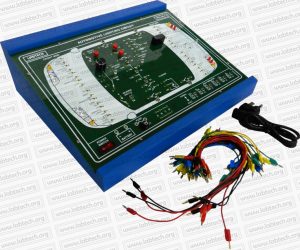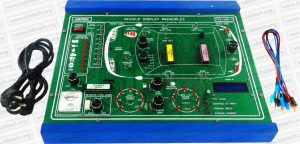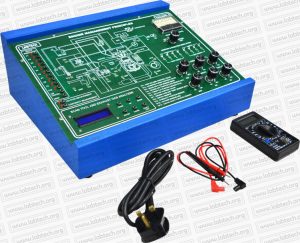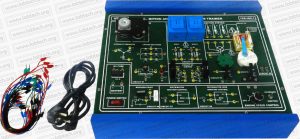Automotive Lighting Circuit
Investigating a simple vanity light circuit using multimeter. Troubleshoot a faulty vanity light circuit with a multimeter. Build an interior light circuit operated by a door contact and add a manual override. Troubleshoot a faulty brake (stop) light circuit with a multimeter. Investigating a reversing (backup) light circuit with a multimeter. Troubleshooting a faulty Lo/Hi beam circuit. Investigating flasher and it’s circuit. Troubleshooting a faulty hazard warning circuit, turn signal circuit & park and tail circuit. Build a hazard warning circuit, relay-operated headlamp circuit and complete vehicle lighting system.
Model Number: ATF-ALC-1
Vehicle Display Principles
Study of coil type and bi-metal gauges and their basic operation. Familiarization of functions of speed and crankshaft (PIP) sensors. Observe speed sensor signal when vehicle speed varies. Study the operating principle of the warning indicator failure detection system. Diagnose faults in the coolant temperature indication circuit. Understand how to test gauges through the sender feed wire grounding. Diagnose faults in air bag system & the vehicle lighting indication system. Understand operation and function of the impact sensor in SRS system, fuel level sensor signals and the connection to engine ECU. Using oscilloscope to observe ultrasonic parking sensor signal and vehicle speed sensor signal. Understand operating principle of the oil pressure indication circuit and low oil level warning lamp system. Understanding average speed, average economy, distance to empty and time lapse calculation and application for vehicle instrument display system.
Model Number: ATF-VDP-1
Engine Management Principles
Using schematic and block diagrams in automotive electronics. Identify a typical ECU Voltage reference values. Study the functions of both crankshaft and camshaft position sensors. Identify correct operation of the engine coolant temperature sensor. Identify the advantages of computer-controlled vehicle systems. Convert flash type trouble codes into OBDII codes. Observe the influence of engine temperature to injection time. Recognize that air to fuel (A/F) ratio is affected by injector open time. Troubleshooting fuel injectors circuit and Diagnose faults. Recognize the operating principle of air injection (turbo system). Activate computer self-diagnosis for troubleshooting purposes.
Model Number: ATF-EMP-1
Ignition and Charging System
Recognize the differences in construction and operating principle between the dynamo and alternator. Recognize the operating principle of the transistor driver circuit for contact breaker ignition system. Identify types of sensors required for the ECU to generate proper timing for spark ignitions.Understand the dwell angle and its effect to the spark ignition and engine performance. Explain the function of mechanical commutator in a dynamo to rectify current. Identify the secondary wave patterns of each cylinder of a multi-cylinder engine. Measure the resistance and voltage at the coil primary and secondary windings. Observe the waveform of an inductive pickup ignition circuit with an oscilloscope. Recognize the operating principle of the ignition coil. Recognize the principle of the PN transistor junction. Diagnose faults in the rotor circuit.
Model Number: ATF-IGC-1




